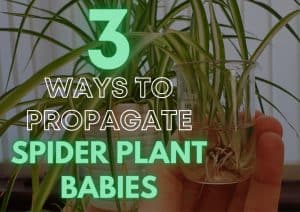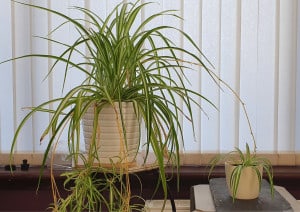Should I Cut The Babies Off My Spider Plant?
-
Chris Dosser
- January 17, 2022
If you buy something using the retail links in our articles, sometimes we earn a small affiliate commission. This does not impact the products we recommend.
The spider plant, also known as the airplane plant or ribbon plant, sure is a popular houseplant. They’re easy to grow and hard to kill, making them perfect for your home or office (plus, they look really neat in hanging planters!)
If you have been caring for your spider for any length of time, you’ll have noticed that your main plant has birthed one or more baby spider plants, called spiderettes. These “babies” will hang down from the “mother” plant like little spiders hanging from a web.
Once your spider plant has reached maturity and begun producing spiderettes, sometimes in great numbers, you might be wondering whether you have a limited window to plant them up before they wither and die, or alternatively sap the nutrients from the mother plant to a point where it can no longer support itself.
There is no benefit to the mother plant by removing spider plant babies, nor are there severe consequences to leaving them to grow large upon the flower stem.
If you choose to leave spiderettes attached to the mother spider plant, you will have to take a few steps to ensure that both the main plant and the babies thrive, including slightly increasing the volume of water and nutrients you provide to the mother plant.
If the plant is growing in a hanging basket, you should be aware of the additional weight that bundles of bushy babies can add.
If you do decide to prune your spider plant, you’ll need to know what you can do with the spiderettes. Below we’ll cover (among a few other things):
- Pruning your spider plant
- Propagating spider plants
- How to care for spiderettes
If you would like to see the progress some of our own spider plant babies have made after being propagated using three different methods, our guide can be found here.
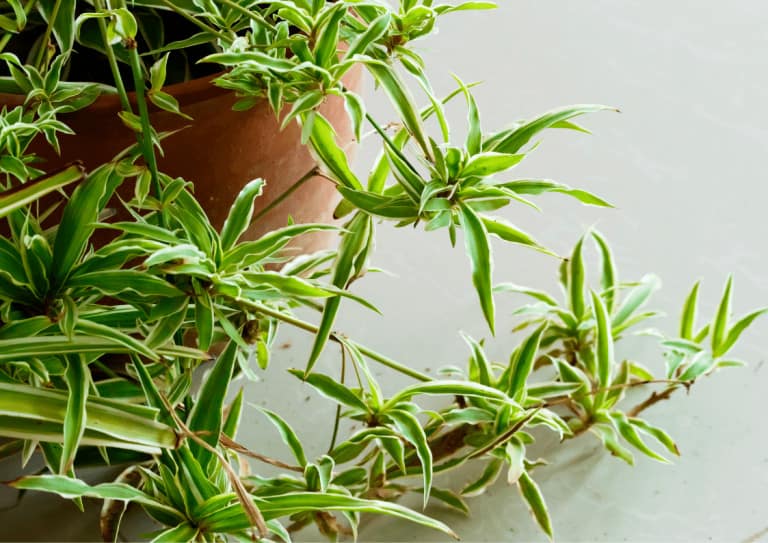
Will leaving spider plant babies attached harm the mother plant?
Leaving the spiderettes on the mother spider plant will pose no harm to the main plant. If you choose not to remove the babies, you will need to ensure that you are adequately watering and fertilizing the mother spider plant.
As spider plants tend to produce more offshoots when they are rootbound in their pots, the amount of growing medium to store and release water back to the root system might be less than you think. For less maintenance make sure you are using soil that is heavy in organic matter that holds moisture but also promotes aeration. Think coco coir, coco husk or bark chips.
If your spider plant is in a hanging basket, leaving the babies will increase the weight of your plant. You can counter this issue by adding a pot pedestal to the main spider plant.
Choosing to cut or leave the spiderettes is entirely up to you as neither course of action has been demonstrated to have any positive or negative effect on the welfare of the adult or babies.
In fact, our own spider plant has supported the same spiderettes for well over a year now.
Our Favorite Spider Plants And Supplies On Etsy
Pruning your spider plant
If the babies are causing your spider plant to look a bit messy or taking up more space than you have available, you can take steps to properly prune the main plant.
Any foliage that is pruned should be cut at the leaf base with a pair of sharp, clean pair of pruning shears or scissors. Be sure to remove all diseased, dead, or discolored foliage from your plant.
To properly remove the babies, use your cleaned pruning shears or scissors to remove the long stems from both the main plant and the spiderettes, cutting as close to the base as possible.
Once you have removed the spiderettes from the mother spider plant, you have two options: discard them or propagate them.
How to propagate spiderettes
Propagating spider plant babies is pretty simple and even those with a ‘not-so-green’ thumb should be able to pull it off. There are a few different methods to propagate spiderettes.
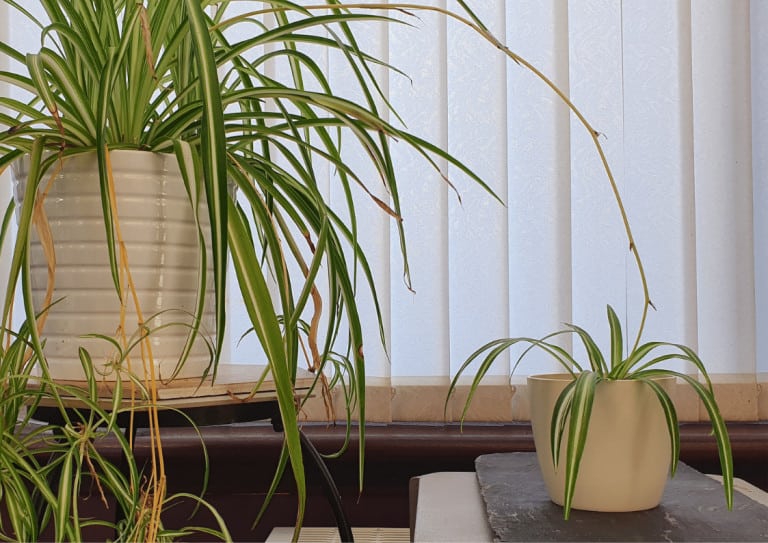
Propagation before cutting
This propagation method mimics how spider plants multiply in nature by allowing the spiderettes to establish roots in the soil before cutting the baby plant away from the mother.
Take small pots filled with moist soil, let the spiderettes dangle down, and take root. You do not have to place the spiderettes deeply into the pots for this to be successful since only the starter roots need to contact the soil.
Once the spiderette begins showing signs of new growth, propagation is successful. You can cut the baby plant away from the mother. You do not have to remove the long connecting stem, as it will eventually be naturally severed. Still, it is a bit easier (and quicker) to do the trimming yourself.
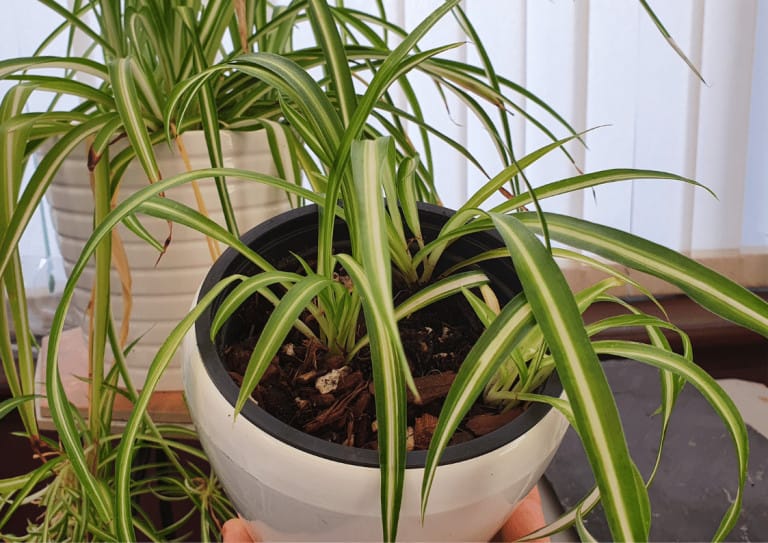
Direct planting
Another propagation method is to directly plant properly pruned spiderettes into prepared soil.
Prepare your pots with moist soil and place the freshly cut babies directly in the pots. Root establishment may take a bit of time, but patience is key.
Once new growth is seen, propagation is a success!
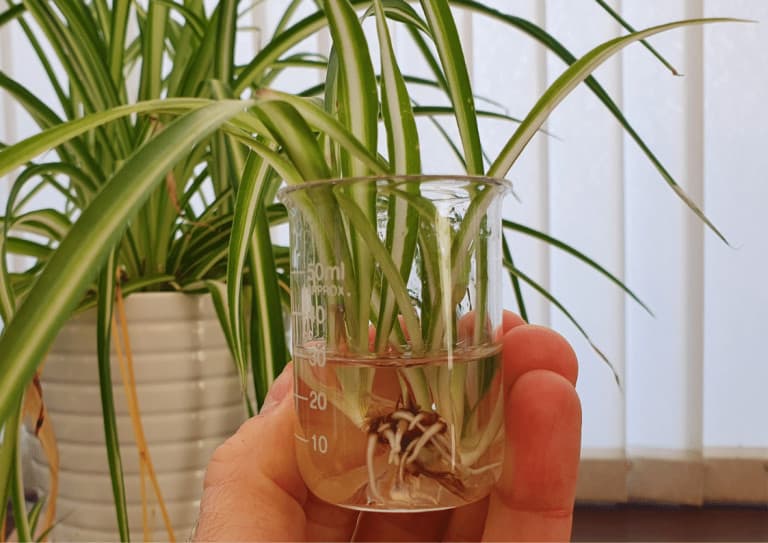
Water propagation
The last and most common method to propagate your spiderettes is water propagation. Water propagation ensures quality root establishment before transferring the new plants into a soil medium.
After carefully pruning the baby spider plants from the mother, you simply place the spiderette in a small glass or bowl containing enough water to cover the starter roots. Be sure to regularly change the water until there is sufficient root development.
Once you feel that the roots of your baby spider plant have developed well, transfer the spiderette to a small, soil-filled pot to continue growth.
All three methods of spider plant propagation are equally effective and reliable. The choice you make will depend on which option seems the most appealing to you.
How to properly care for your spiderettes
Spider plants are hardy little guys that are easily cared for. These tips will enable your spiderettes to thrive and become just as resilient as their mother:
- Use a lightweight potting soil with plenty of moisture holding organic material
- Fertilize newly propagated plants sparingly, twice a month at most
- Do not place babies in direct sunlight – aim instead for plenty of indirect sunlight
- Check for pests regularly – especially upon the soil surface
Final thoughts
Now that you know a bit more about pruning your spider plant and propagating and caring for spiderettes, you can feel a bit more secure knowing that whether or not you cut the babies off your spider plant will make no difference to the mature plant or its offspring.

Chris Dosser
Co-Founder of Eden Indoors
Chris is a self-taught horticulturist with over a decade of experience caring for houseplants and creating lush, thriving indoor oases. He specializes in Monstera, and by self admission has a serious problem with buying and propagating rare indoor plants!
Similar Posts
3 Ways To Propagate Spider Plant Babies
Our adult spider plant has produced so many offsets that we had the chance to test several methods of propagating spider plant babies.
When Do Spider Plants Have Spider Babies?
Discover when and why spider plants have spider babies and troubleshoot why your plant might not yet have produced offsets.

